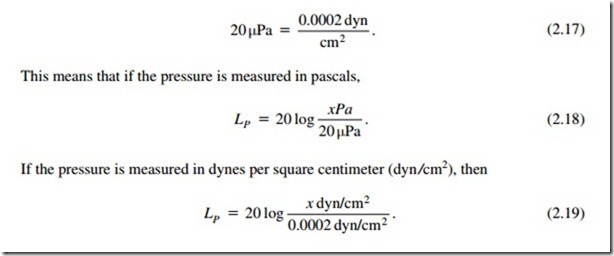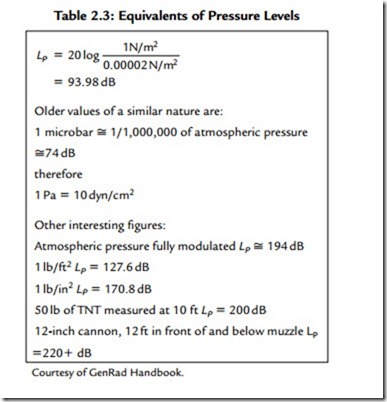The Decibel in Acoustics—LP, LW, and LI
In acoustics, the ratios encountered most commonly are changes in pressure levels. First, there must be a reference. The older level was 0.0002 dyn/cm2, but this has recently been changed to 0.00002 N/m2 (20 μN/m2). Note that 0.0002 dyn/cm2 is exactly the same sound
pressure as 0.00002 N/m2. Even more recently the standards group has named this same
pressure pascals (Pa) and arranged this new unit so that
where Prms is in pascals, f is the frequency in Hertz (Hz), A is particle displacement in meters (rms value), ρ is the density of air in kilograms per cubic meter (kg/m3), c is the velocity of sound in meters per second (m/s), ρc = 406 RAYLS and is called the characteristic acoustic resistance (this value can
These are identical sound pressure levels bearing different labels. Sound pressure levels were identified as dB-SPL, and sound power levels were identified as dB-PWL. Currently, LP is preferred for sound pressure level and LW for sound power level. Sound intensity level is LI:
At sea level, atmospheric pressure is equal to 2116 1 b/ft2. Remember the old physics laboratory stunt of partially filling an oil can with water, boiling the water, and then quickly sealing the can and putting it under the cold water faucet to condense the steam so that the atmospheric pressure would crush the can as the steam condensed, leaving a partial vacuum?
This represents the complete modulation of atmospheric pressure and would be the largest possible sinusoid. Note that the sound pressure (SP) is analogous to voltage. An LP of 200 dB is the pressure generated by 50 lb of TNT at 10 ft. Table 2.3 shows the equivalents of sound pressure levels.
For additional insights into these basic relationships, the Handbook of Noise Measurement by Peterson and Gross is thorough, accurate, and readable.




